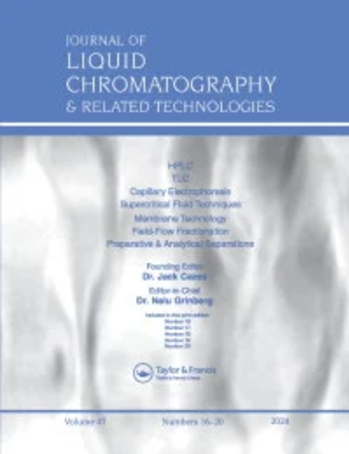HPLC-DAD-ESI-MS对藏药雪莲中黄酮类化合物含量的比较研究
IF 1.2
4区 化学
Q4 BIOCHEMICAL RESEARCH METHODS
Journal of Liquid Chromatography & Related Technologies
Pub Date : 2022-07-21
DOI:10.1080/10826076.2023.2165096
引用次数: 1
摘要
摘要西藏和维吾尔族地区“雪莲”有三种,即雪莲、水母雪莲和大雪莲,作为民间药材互换配用。为了验证这一现象的可行性,本研究建立了HPLC-DAD-ESI-MS方法,对三种雪莲中黄酮类化合物进行定性和定量测定。检出限和检出限分别为0.0263 ~ 0.1172µg/mL和0.0862 ~ 0.3867µg/mL。仪器精密度验证的相对标准偏差(RSD × 100%)均小于2.03%,方法精密度验证的RSD × 100%均小于5.73%。加样回收率为92.98 ~ 101.79%。这些结果进一步证明了该方法测定三种雪莲属植物中黄酮类化合物的准确性和实用性。本研究根据ESI-MS数据和前人研究同时鉴定出14种成分。采用分光光度法和HPLC-DAD法分别测定其总黄酮和8种成分的含量。结果表明,山葵中总黄酮含量最高,8种总黄酮含量存在一定差异。对天山参进行了芦丁、木犀草素-7- o -葡萄糖苷和hispidulin的检测。其中,牛蒡子苷、芹菜素和牛蒡子苷是主要的类黄酮化合物。在水母水母中,共检测到7种化合物,其中牛蒡子素含量最高,芹菜素含量最低。通过比较研究,可以促进三种雪莲的鉴别利用。图形抽象本文章由计算机程序翻译,如有差异,请以英文原文为准。
Comparative study on flavonoids from Tibetan medicinal plants Saussurea species using HPLC-DAD-ESI-MS
Abstract Three kinds of “Snowlotus” including Saussurea involucrate, Saussurea medusa and Saussurea laniceps had been prescribed as folk medicine interchangeably in Tibet and Uygur, China. To verify the feasibility of this phenomenon, a HPLC-DAD-ESI-MS method was developed in this study to determine the flavonoid compounds from three Saussurea species qualitatively and quantitatively. The LODs and LOQs ranged from 0.0263–0.1172 µg/mL and 0.0862–0.3867 µg/mL, respectively. The relative standard deviation (RSD × 100%) of the validation for the instrument precision was below 2.03%, while the RSD × 100% values for the method precision were below 5.73%, respectively. The recoveries ranged from 92.98–101.79%. These results further demonstrated that this method was precise and practical for determining flavonoid compounds from three Saussurea species. In this study, 14 kinds of constituents were simultaneously identified according to the ESI-MS data and previous studies. The contents of total flavonoids and eight components were determined with spectrophotometry and HPLC-DAD methods, respectively. The results demonstrated that the total flavonoids in S. involucrate had the hightest value and there were some differences in the content of eight flavonoids. For S. involucrate, a proportion of rutin, luteolin-7-O-glucoside, and hispidulin were detected. For S. laniceps, Arctiin, apigenin, and arctigenin were the major flavonoid compounds. For S. medusa, seven types of compounds were detected and arctiin presented the highest value, whereas apigenlin exhibited the lowest value. This comparative study may promote the differentiation in use of three kinds of snowlotus. Graphical abstract
求助全文
通过发布文献求助,成功后即可免费获取论文全文。
去求助
来源期刊
CiteScore
2.80
自引率
0.00%
发文量
29
审稿时长
4.9 months
期刊介绍:
The Journal of Liquid Chromatography & Related Technologies is an internationally acclaimed forum for fast publication of critical, peer reviewed manuscripts dealing with analytical, preparative and process scale liquid chromatography and all of its related technologies, including TLC, capillary electrophoresis, capillary electrochromatography, supercritical fluid chromatography and extraction, field-flow technologies, affinity, and much more. New separation methodologies are added when they are developed. Papers dealing with research and development results, as well as critical reviews of important technologies, are published in the Journal.

 求助内容:
求助内容: 应助结果提醒方式:
应助结果提醒方式:


